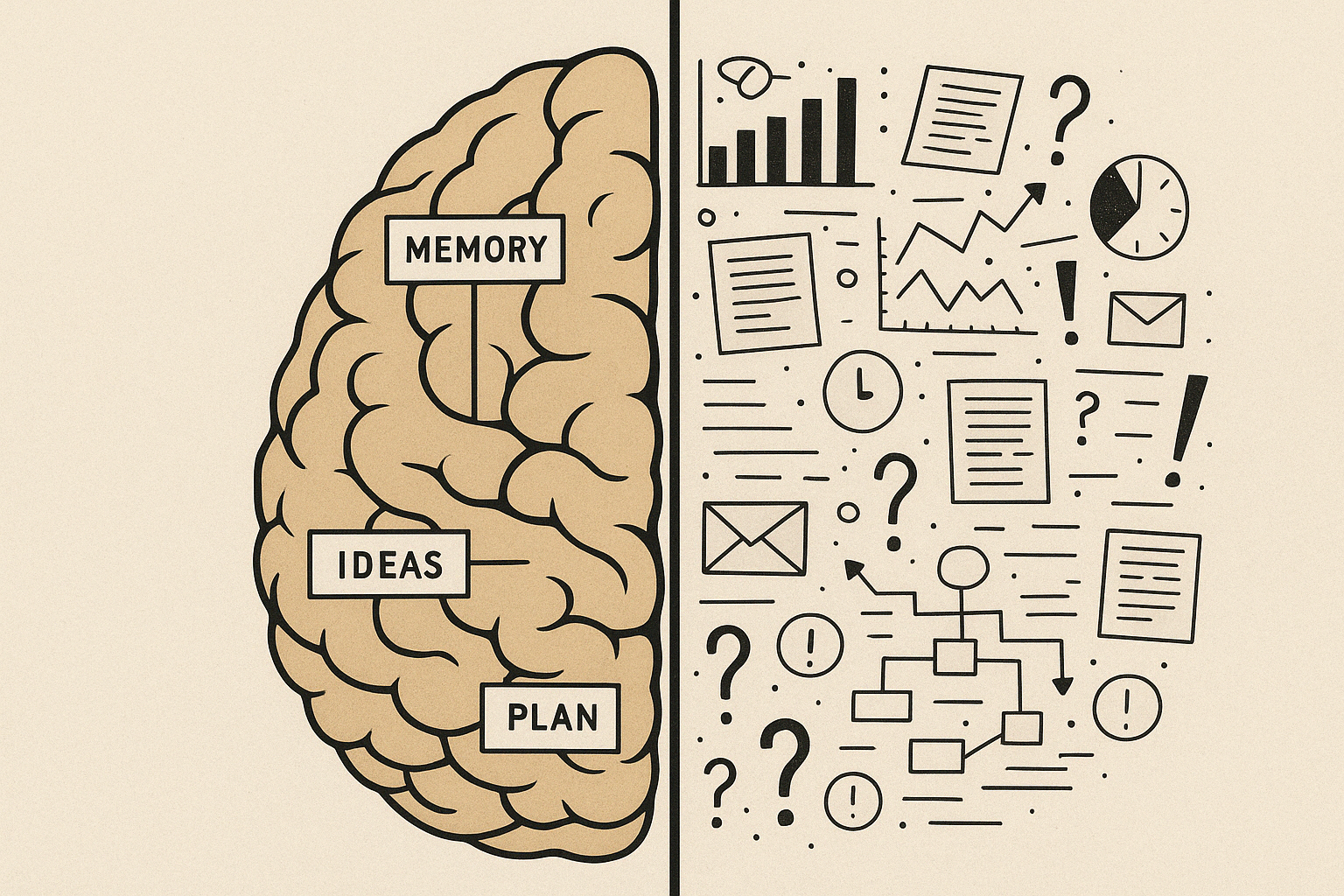

The Working Memory Battleground: Fighting for Cognitive Real Estate in Learning Design
Introduction: The Working Memory Challenge
I recently sat in on a clinical orientation where new nurses were expected to absorb 47 policies in a four-hour session. I watched their faces transition from engagement to overwhelm to resignation - a perfect example of working memory limitations in action.
Every learning experience involves a battle for limited cognitive real estate. The research on working memory - our mental workspace for processing new information - presents a sobering reality: we can only hold about four chunks of information in mind simultaneously. Exceed this limit, and comprehension suffers dramatically.
Yet most training materials seem designed as if working memory were infinite. Slides packed with bullet points, narration that diverges from on-screen text, complex diagrams with inadequate explanation - all of these create what I call "Cognitive Overwhelm Points" where learning effectively stops.
I recently reviewed a healthcare compliance module that managed to violate every evidence-based principle of multimedia learning. Text-dense slides with identical narration, decorative animations that served no instructional purpose, and complex procedures presented without segmentation. It wasn't just bad design - it was neurologically hostile.
The Science Behind Working Memory
Cognitive load theory, developed by John Sweller and colleagues, explains why these design approaches fail. Our cognitive architecture includes a severely limited working memory that must process new information before it can transfer to our relatively unlimited long-term memory.
This processing involves three types of cognitive load:
Intrinsic load: The inherent complexity of the material itself
Extraneous load: Unnecessary mental effort caused by poor design
Germane load: Productive mental effort that contributes to learning
"Every unnecessary design element, confusing instruction, or extraneous piece of information is actively stealing cognitive resources from your learners."
The evidence speaks for itself - despite being consistently ignored in practice - when extraneous load is high, learners have insufficient working memory capacity remaining for the intrinsic and germane load that actually matter.
Research by Mayer and Moreno demonstrated that students who learned from well-designed multimedia that respected cognitive limitations outperformed those who received the same content in formats that overwhelmed working memory. Similar findings from van Merriënboer's work on complex learning show that properly sequenced information leads to significantly better skill development, particularly in healthcare settings. The performance differences weren't marginal - they were substantial, often showing 50-100% improvements in both retention and transfer measures.
In practical terms? Every unnecessary design element, confusing instruction, or extraneous piece of information is actively stealing cognitive resources from your learners.
The Reality Check: How Most Learning Violates Cognitive Principles
Let's be honest - most organizational learning experiences seem deliberately designed to overwhelm working memory.
PowerPoint presentations with 7-10 bullet points per slide, each containing complete sentences. E-learning that forces learners to read on-screen text while simultaneously listening to slightly different narration. Complex processes presented all at once instead of in meaningful segments. Visual designs where decorative elements compete with instructional content for attention.
This isn't just ineffective - it's wasteful. Organizations invest substantial resources in creating learning experiences that virtually guarantee cognitive overload, then wonder why performance doesn't improve.
"Most training fails not because learners aren't trying hard enough, but because the design of the training makes meaningful processing nearly impossible."
The harsh truth is that most training fails not because learners aren't trying hard enough, but because the design of the training makes meaningful processing nearly impossible. It's like trying to pour water into a glass that's already full - no matter how good your content is, there's simply nowhere for it to go in the learner's overwhelmed working memory.
I've witnessed healthcare professionals - intelligent, motivated learners - struggle through training that required them to simultaneously read complex procedures, listen to explanations, interpret diagrams, and make connections to prior knowledge. During a medication safety training, I watched experienced pharmacists miss critical information simply because it was buried in slide 47 of a 60-slide presentation with no breaks or processing time. The cognitive architecture simply doesn't support this level of simultaneous processing, regardless of intelligence or motivation.
The Cognitive Efficiency Framework
Rather than viewing cognitive limitations as an inconvenience, what if we embraced them as a clarifying constraint? This perspective transforms how we approach learning design.
I've developed what I call the "Cognitive Efficiency Framework" - an approach that optimizes learning by strategically managing each type of cognitive load:
Managing Intrinsic Load
Sequence content from simple to complex
Use pre-training for key concepts and terminology
Break complex processes into meaningful segments
Provide worked examples before practice problems
Eliminating Extraneous Load
Remove decorative elements that don't contribute to learning
Ensure visual and auditory elements complement rather than compete
Present related information together spatially and temporally
Use consistent navigation and interaction patterns
Optimizing Germane Load
Direct attention to relevant patterns and relationships
Provide varied practice with appropriate scaffolding
Include self-explanation prompts that deepen processing
Create opportunities for elaboration and connection-making
"Like a physical therapist who understands biomechanical limitations, an effective learning designer respects cognitive constraints while progressively building capacity."
Like a physical therapist who understands biomechanical limitations, an effective learning designer respects cognitive constraints while progressively building capacity. Just as you wouldn't expect a patient recovering from surgery to immediately return to full activity, we shouldn't expect learners to process complex new information without proper scaffolding and support.
Practical Techniques in Action
Let's examine how this plays out in healthcare education, where complex content often meets poor design.
I recently redesigned a medication administration module for high-risk medications (including anticoagulants and insulin) that was failing to improve error rates despite comprehensive content. Medication errors with these drugs can be life-threatening, yet the original training design presented the entire procedure at once, with 27 steps and multiple cautions and rationales intermingled. Nurses were completing the training but still making critical errors - particularly around dose calculations and patient monitoring requirements.
Applying cognitive load principles, we:
Segmented the procedure into meaningful chunks based on cognitive boundaries, not just procedural sequence. We identified natural breaking points where one set of related actions ended and another began, creating five distinct segments instead of one overwhelming list. For insulin administration, this meant separating preparation, dose verification, administration technique, documentation, and monitoring into separate but connected learning segments.
Created a layered approach that separated core actions from rationales and exceptions. The essential procedure steps remained visible while supplementary information was available through clearly marked expansions, allowing learners to process the core sequence before adding complexity. This was particularly important for the dose calculation components, where multiple verification steps were needed.
Developed a visual framework that made the procedure structure visible at a glance. The visual organization reflected the conceptual organization, reducing the cognitive effort required to understand the relationship between steps. Color-coding connected related steps across different phases of the procedure.
Replaced text-heavy explanations with simple visuals where appropriate. For concepts like checking wristbands against medication records, we used simple comparative images rather than lengthy explanations of the matching process. For insulin syringe preparation, we used annotated photos instead of text descriptions.
Added strategic practice after each segment rather than only at the end. This allowed learners to consolidate their understanding of each component before moving to the next, building cognitive schema progressively. We included realistic scenarios that required application of specific procedure elements.
The results were significant: completion rates increased by 37%, assessment scores improved by 22%, and most importantly, medication error rates decreased by 28% in the three months following implementation. The nursing education department reported that staff were not only making fewer errors but were more confident in handling these high-risk medications.
This wasn't magic - it was simply applying what cognitive science has been telling us for decades.
Implementation Guidance
Implementing these principles in real-world learning development requires both tactical know-how and strategic persuasion. Here's how to start:
Begin with a cognitive load audit of existing materials:
Where are you presenting too much information simultaneously?
What visual elements are decorative rather than instructional?
How could you segment complex content into manageable chunks?
Where could you reduce text and use meaningful visuals instead?
What prerequisite knowledge could you address separately?
Start small with high-impact changes. Small changes often yield significant improvements. I've seen completion rates double simply by breaking a 20-minute module into four 5-minute segments with clear connections.
Become a cognitive advocate. You may need to push back against stakeholders who want to include "just one more thing" in already-full learning experiences. I once had to firmly but respectfully tell a chief medical officer that adding his "just two additional slides" on regulatory context would undermine the effectiveness of an already-optimized resuscitation training. Frame your advocacy in terms of effectiveness and results rather than theory - stakeholders care more about outcomes than cognitive architecture.
Use before/after demonstrations. Nothing convinces stakeholders like seeing the difference. Create simple prototypes showing both the conventional approach and your cognitively-optimized alternative, then ask which they find clearer and easier to process.
Address the "dumbing down" objection directly. When you remove unnecessary complexity, some stakeholders will worry you're "dumbing down" the content. Explain that you're actually making the content more accessible without reducing its substance - like a well-edited book that's clearer and more powerful than its bloated first draft.
"The pattern becomes clear when you step back: effective learning isn't about covering everything, but about presenting information in ways that respect how the human mind actually works."
The pattern becomes clear when you step back: effective learning isn't about covering everything, but about presenting information in ways that respect how the human mind actually works.
Conclusion: Respecting the Mind
There's an ethical dimension to this discussion that often goes unaddressed. When we design learning experiences that ignore cognitive limitations, we're not just creating ineffective training - we're potentially causing harm.
"As learning designers, we have a professional and ethical responsibility to advocate for approaches that respect cognitive architecture. This isn't optional - it's a fundamental aspect of our role."
As learning designers, we have a professional and ethical responsibility to advocate for approaches that respect cognitive architecture. This isn't optional - it's a fundamental aspect of our role. When we allow organizational pressures for "comprehensive" content to override what we know about effective learning, we fail both our organizations and the humans who engage with our work.
In healthcare contexts, cognitive overload in training can lead to:
Incomplete understanding of critical procedures
Increased stress and burnout among staff
Reduced confidence in applying knowledge
Workarounds that compromise patient safety
Resistance to future training initiatives
I consider it a professional obligation to advocate for designs that respect cognitive architecture. This isn't just about learning effectiveness - it's about caring for the humans on the receiving end of our work.
The research on working memory isn't new. We've known about these limitations for decades. Yet the gap between what we know and what we practice remains substantial in most organizations.
This is where theory meets practice: cognitive load principles aren't academic abstractions but practical tools for creating learning that respects how the human mind actually works.
Let's sit with that question for a moment: What might our learning ecosystems look like if we designed them with as much attention to cognitive architecture as we pay to visual aesthetics or technological capabilities?
